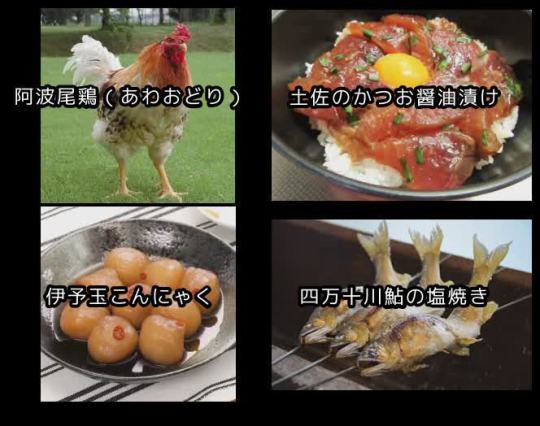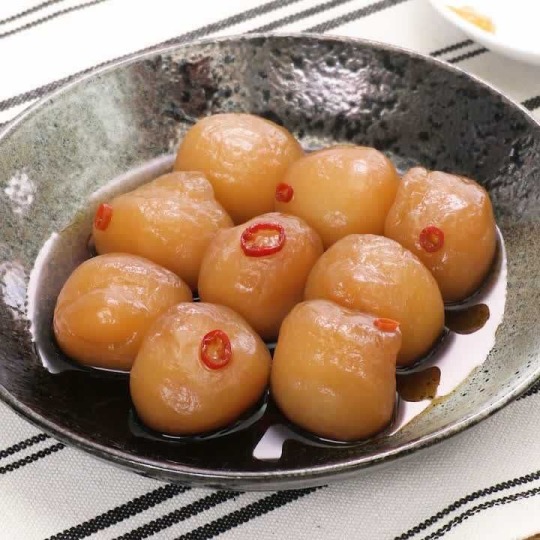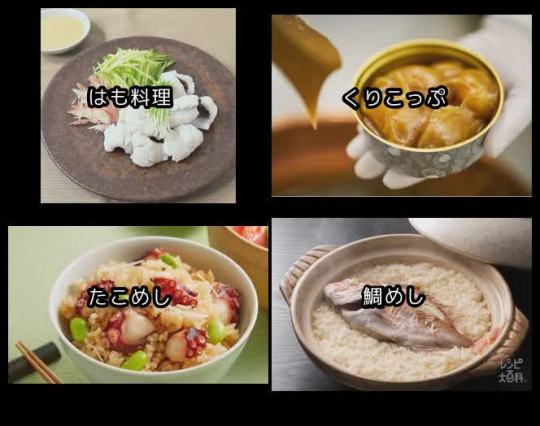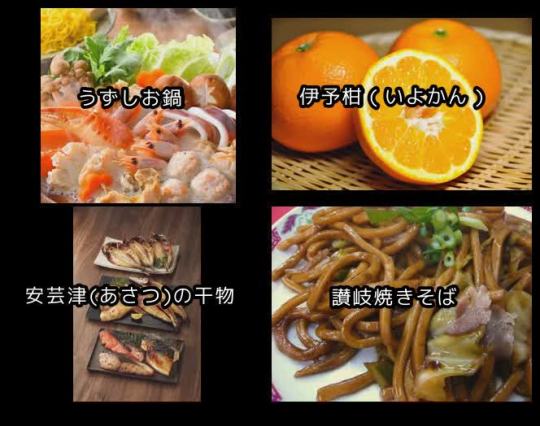#Ehime cuisine
Explore tagged Tumblr posts
Text
料理トリビアのまとめ #0023

#阿波尾鶏(あわおどり)#Tokushima ingredients#料理トリビア#JapaneseCooking#Iyotama Konnyaku#四万十川料理#Salt-grilled Shimanto River sweetfish#土佐のかつお醤油漬け#高知の料理#四万十川鮎の塩焼き#Shimanto River cuisine#Tosa bonito pickled in soy sauce#徳島の食材#Kochi cuisine#愛媛の料理#伊予玉こんにゃく#Ehime cuisine#Awa Odori (Awa Odori)
0 notes
Photo

伊予玉こんにゃく 愛媛の料理
伊予玉こんにゃくは、愛媛県を代表する伝統的な食品の一つで、こんにゃく芋を原料として作られます。こんにゃくは日本全国で知られており、その中でも伊予玉こんにゃくは特に愛媛県で作られる伝統的な商品です。 1. 地元のこんにゃく��を使用 伊予玉こんにゃくは、愛媛県産のこんにゃく芋を原料として作られます。地元の良質なこんにゃく芋を使用することで、品質の高い伊予玉こんにゃくが作られます。 2. 甘辛く煮た料理 伊予玉こんにゃくは、こんにゃくを甘辛く煮た料理です。一般的には、だし汁や醤油、砂糖、みりんなどで味付けされ、煮込まれます。 3. 独特の歯ごたえと風味 こんにゃく特有の歯ごたえがあり、独特の食感と風味を楽しむことができます。コシのある歯ごたえが特徴的です。 4. ヘルシーな食品 こんにゃくは低カロリーで食物繊維も豊富であり、ヘルシーな食品として知られています。
✄🔪🥄🍽✄🔪🥄🍽✄🔪🥄🍽✄🔪🥄🍽
Iyotama Konnyaku Ehime cuisine
Iyotama konnyaku is one of the traditional foods representing Ehime Prefecture, and is made from konnyaku potatoes. Konnyaku is known all over Japan, and Iyotama Konnyaku is a traditional product especially produced in Ehime Prefecture. 1. Using local konjac potatoes Iyotama Konnyaku is made from konnyaku potatoes grown in Ehime Prefecture. By using high-quality local konjac potatoes, high-quality Iyotama konnyaku is produced. 2. Sweet and spicy boiled dishes Iyotama konnyaku is a sweet and spicy simmered konnyaku dish. Generally, it is seasoned with dashi stock, soy sauce, sugar, mirin, etc., and then simmered. 3. Unique texture and flavor It has the unique texture of konnyaku, and you can enjoy its unique texture and flavor. It is characterized by its chewy texture. 4. Healthy food Konnyaku is low in calories and rich in dietary fiber, making it known as a healthy food.
0 notes
Text
Cuisine and culture from Shikoku’s waters and nature
// Intresting article about the cuisine and culture of Shikoku Japan
1 note
·
View note
Text
Aragoshi Lemon
UMENOYADO SAKE BREWERY

Brewery UMENOYADO SAKE BREWERY co.,ltd. Raw liquor Lemon soaked sake、sake, distilled alcohol Ingredients Lemon, sweetener, honey, citric acid Alcohol content 10% Volume(ml) 1800 ml, 720 ml Manufacture process The lemon rind is soaked in distilled alcohol to make a bitter, aromatic lemon-soaked liqueur. Then, sake, sugar, and citric acid is dissolved within, blended together with lemon juice, honey, and minced lemon. To maximize the balance of the lemon’s sweetness, sourness, and fragrance, the squeezed extracts are immediately frozen and then slowly thawed. By using these advanced sterilization techniques, the flavor of the lemon is preserved. The lemon rind is then added to the aromatic lemon mince, and then carefully bottled so as not to destroy the grainy texture. Fruits & vegetables used Lemon Origin Hiroshima Prefecture, Ehime Prefecture, Oita Prefecture, Kagoshima Prefecture, others Characteristics of used fruit and vegetables The lemon juice used is from the Setouchi area and is thought to be of the highest quality in Japan. Due to the lemons’ vulnerability to the cold, they are mainly cultivated in areas of Japan similar to the Mediterranean climate of Italy, where the winters are warm and the summers are dry. Pesticides in post-harvest crops are prohibited in Japan, which allows for soaked liqueur to be produced safely using fruit rinds. Tasting comment The color seems to be a mix of both yellow and amber. The minced lemon presents a calming image. A complex, three-dimensional aroma is created with a strong fresh scent of lemons and a calm, deep aroma. The aroma profile changes depending on the drinking temperature. Diluting with soda provides a sharper sensation, while diluting with hot water accentuates the sweet scent of honey. It has a solid acidic impact, with the soft sweetness of honey, and the umami and bitterness of the lemon. Recommended drinking temperature 5~60℃ Recommended drinking method With soda, or as an aperitif with hot water. The amount of sake is approximately 1:3 ~ 1:2. Add a small amount to straight black tea, or mix with beer to make lemon beer. Storage method Room temperature Compatible local cuisine and ingredients Fried chicken
1 note
·
View note
Text
Miwaku No Yuzu
Maruishi Jozo

Nom de la société Maruishi Jozo Co., Ltd. Alcool brut Pur saké brut (fabriqué dans nos propres installations à base de riz d'Aichi) Ingrédients Saké (pur saké de riz), jus de yuzu, fructose Teneur en alcool 7% Volume(ml) 500 ml / 1800 ml Processus de fabrication Il est fait à base de vin de riz pur traditionnel, brassé en collaboration avec des agriculteurs sous contrat à Okazaki, à base du riz Banzai d'Okazaki, qui a été présenté à l'empereur Taisho lorsqu'il est monté sur le trône il y a 100 ans. Aucun acidifiant ni additif n'était utilisé, et les quantités de pulpe étaient maximisées afin de rehausser le goût et l'arôme originaux du fruit, ce qui donnait une liqueur puissamment fruitée. Il contient la quantité parfaite d'huile extraite de la peau des agrumes, pour donner de la chair à la saveur aigre du yuzu. Fruits et légumes utilisés Kito Yuzu Origine Ehime Caractéristiques des fruits et légumes utilisés Fabriqué avec Kito yuzu de Ehime. C'est une variante qui a un arôme fort et vif, et une forte acidité. Commentaire de dégustation Il a un riche arôme de yuzu et une acidité claire et rafraîchissante. Température de consommation recommandée Réfrigéré. Méthode de consommation recommandée Réfrigéré, avec de la glace, coupé avec du soda, ou comme base pour des cocktails. Méthode de stockage Endroits frais et sombres (doit être réfrigéré après ouverture) Cuisine et ingrédients locaux compatibles Ailes de poulet frites, boulettes et peau de poisson soufflé bouillie.
0 notes
Text
Plant-based cuisine: Modernizing Japan's vegetarian traditions
#Washoku #Tempura [The Japan Times]Mountain-to-table: Rice, pickles and tempura wild plants form the foundation of this plant-based meal from Ehime Prefecture. | MOMOKO NAKAMURA From fermented products to shōjin ryōri (traditional …
0 notes
Text
料理トリビアのまとめ #0020

#Hamo dishes#はも料理#東海地方の料理#Kurikoppu#Nagano cuisine#たこめし#Tokai region cuisine#JapaneseCooking#くりこっぷ#愛媛の料理#Tokushima cuisine#Sea bream rice#Octopus rice#徳島の料理#Ehime cuisine#鯛めし#料理トリビア#長野の料理
0 notes
Photo

たこめし 愛媛の料理
「たこめし」は、四国地方(特に愛媛県)で親しまれている郷土料理の一つです。たこめしは、タコを炊き込んだご飯のことを指します。 1. タコとご飯の組み合わせ 炊き込まれたご飯にタコを加えて炊き上げることで、タコの旨味がご飯に染み込み、ほのかなタコの風味が楽しめます。 2. 地域によるバリエーション 愛媛県を中心に親しまれていますが、地域によって具材や味付けが異なることがあります。 3. おにぎりや弁当にも たこめしは単品で食べられるだけでなく、おにぎりや弁当の具としても利用されることがあります。 四国地方の代表的な海産物であるタコを活かした郷土料理であり、地元の食文化や新鮮な地元食材を味わうことができる料理です。
✄🔪🥄🍽✄🔪🥄🍽✄🔪🥄🍽✄🔪🥄🍽
Octopus rice Ehime cuisine
"Takomeshi" is one of the local dishes that is popular in the Shikoku region (especially Ehime Prefecture). Takomeshi refers to rice cooked with octopus. 1. Octopus and rice combination By adding octopus to the rice and cooking it, the umami of the octopus permeates into the rice, allowing you to enjoy the subtle octopus flavor. 2. Regional variations It is popular mainly in Ehime Prefecture, but the ingredients and seasoning may vary depending on the region. 3. For rice balls and bento boxes Takomeshi can not only be eaten alone, but may also be used as an ingredient in rice balls or bento boxes. This is a local dish that makes use of octopus, a typical seafood of the Shikoku region, and allows you to enjoy the local food culture and fresh local ingredients.
1 note
·
View note
Text
料理トリビアのまとめ #0022

#Whirlpool hot pot#料理トリビア#JapaneseCooking#Iyokan#Ehime fruits#讃岐焼きそば#高知の料理#香川の料理#Dried fish from Akitsu#Kagawa cuisine#Sanuki Yakisoba#うずしお鍋#Kochi cuisine#安芸津(あさつ)の干物#愛媛の果物#伊予柑(いよかん)
0 notes
Text
Yuzu Liqueur
Miyasaka Brewing Co., Ltd.

Brewery Miyasaka Brewing Co., Ltd. Raw liquor Shoch Ingredients Masumi shochu, yuzu juice, sugar Alcohol content 14% Volume(ml) 300ml 720ml Manufacture process We blend yuzu juice, sugar, and Masumi shochu to make this simple product with natural ingredients and no added preservatives. Fruits & vegetables used Yuzu Origin Ehime Prefecture Characteristics of used fruit and vegetables We use the ripe, fragrant yuzu produced in Ehime's mountainous region. The fruit is pressed with a belt press that works almost as slowly as hand-squeezing to yield juice with almost no bitterness. Tasting comment Yuzu, the magic citrus livening up many Japanese dishes, gets star-billing in this refreshing and delightfully fragrant liqueur. The blend of Masumi shochu and yuzu juice with a modicum of sugar strikes a perfectly sweet and tangy balance. Recommended drinking temperature - Recommended drinking method Straight, On-the-rocks, With sparkling water, With warm water Storage method Room temperature Compatible local cuisine and ingredients Marinated lake smelt; carpaccio with seasonal vegetables
0 notes
Text
Miwaku No Yuzu
Maruishi Jozo

Brewery Maruishi Jozo Co., Ltd. Raw liquor Pure raw sake (manufactured in our own facilities using rice from Aichi) Ingredients Sake (pure rice sake), yuzu juice, fructose Alcohol content 7% Volume(ml) 500ml / 1800ml Manufacture process Made using traditional pure rice wine brewed in cooperation with contracted farmers in Okazaki, using Okazaki's Banzai rice, which was presented to Emperor Taisho when he ascended to the throne 100 years ago. No acidifiers or additives were used, and pulp amounts were maximized to enhance the original taste and aroma of the fruit, resulting in a powerfully fruity liqueur. It contains the perfect amount of oil from the skins of citrus fruits, to flesh out the sour flavor of the yuzu. Fruits & vegetables used Kito Yuzu Origin Ehime Characteristics of used fruit and vegetables Made using Kito yuzu from Ehime. It is a variant that has a strong, bright aroma, and a strong acidity. Tasting comment It has a rich yuzu aroma and a clear, refreshing acidity. Recommended drinking temperature Chilled Recommended drinking method Chilled, with ice, cut with soda, or as a base for cocktails. Storage method Cool, dark places (requires refrigeration after opening) Compatible local cuisine and ingredients Deep-fried chicken wings, dumplings, and boiled puffer fish skin.
0 notes
Text
Yuzu Omoi
Yamamoto Honke

Brewery Yamamoto Honke co.,itd. Raw liquor Sake (junmai-shu) Ingredients Sake, yuzu juice, sweeteners Alcohol content 7% Volume(ml) 500 ml Manufacture process Made using junmai-shu brewed specifically for ‘Yuzu Omoi,’ yuzu juice and sweeteners. Fruits & vegetables used Yuzu Origin Ehime Prefecture Characteristics of used fruit and vegetables Uses yuzu that has a good balance of sourness and umami flavor. Tasting comment The taste is an exquisite balance between the richness of the junmai-shu and the sourness and umami of the yuzu. This is a fine beverage that is quaffable even to those who don’t normally enjoy drinking. Recommended drinking temperature 5℃ Recommended drinking method On-the-rocks, with soda Storage method Keep refrigerated Compatible local cuisine and ingredients Yuzu tofu, yuba (tofu skin)
0 notes
Text
Liqueur Umenoyado Yuzu
UMENOYADO SAKE BREWERY

Nom de la société UMENOYADO SAKE BREWERY Co. , Ltd. Alcool brut Alcool distillé, saké Ingrédients Yuzu, édulcorant Teneur en alcool 8 % Volume(ml) 1 800 ml, 720 ml Processus de fabrication L'alcool distillé et le saké sont mélangés dans un rapport optimal pour accentuer l'arôme du yuzu, puis des édulcorants et du jus de yuzu sont ajoutés et mélangés à basse température. Plus de 20 marques de jus de yuzu provenant de tout le Japon sont mélangées et utilisées. Comme la saveur du jus de yuzu varie en fonction de la culture et des conditions climatiques, la saveur du jus est examinée chaque année et est contrôlée afin de déterminer la saveur de la liqueur de yuzu « Umenoyado ». Le jus de yuzu est pressé dans la zone de production, puis rapidement congelé pour conserver la qualité du jus fraîchement pressé. L'odeur et la couleur du yuzu sont très vulnérables à la chaleur, c'est pourquoi une grande attention est portée à ce que la qualité ne soit pas perdue en le décongelant lentement au fil du temps. Comme le seul jus utilisé est celui qui a été pressé avec la peau, l'arôme et l'amertume sont incroyablement prononcés, de sorte que les derniers ajustements sont effectués pour perfectionner l'équilibre général. Fruits et légumes utilisés Yuzu Origine Préfectures de Kochi, Fukuoka, Oita, Miyazaki, Ehime, Kagoshima, Ibaraki, Chiba, etc. Caractéristiques des fruits et légumes utilisés Le yuzu est un agrume typiquement japonais, appartenant à la famille des mandarines, qui se caractérise par son arôme et son acidité. Il est principalement cultivé à Shikoku et Kyushu, dans des régions telles que les préfectures de Kochi et de Tokushima, et possède une aigreur fraîche semblable à celle du citron, ainsi qu'un élément amer unique. Commentaire de dégustation Sa couleur est d'un jaune profond et brillant avec une teinte blanche, avec un film d'huile sur le dessus, et un éclat semblable à celui d'une pierre précieuse. L'odeur est splendide et pénètre le nez, étant assez puissante pour circuler dans tout le corps. L'acidité pure et puissante et l'amertume complexe sont harmonisées avec la douceur moelleuse et abondante de l'umami et la puissance enveloppante du saké, présentant une note finale élégante. Température de consommation recommandée entre 5 et 10℃ Méthode de consommation recommandée Avec des glaçons, avec du soda. Ajoutez une petite quantité pour faire un spritz avec du gin. Méthode de stockage Endroit frais et sombre. Nécessite une réfrigération après ouverture. Cuisine et ingrédients locaux compatibles Accompagne parfaitement les plats de viande riches comme les salaisons et les yakitori.
0 notes
Text
Citron Aragoshi
UMENOYADO SAKE BREWERY

Nom de la société UMENOYADO SAKE BREWERY Co. , Ltd. Alcool brut Saké trempé au citron, saké, alcool distillé Ingrédients Citron, édulcorant, miel, acide citrique Teneur en alcool 10% Volume(ml) 1 800 ml, 720 ml Processus de fabrication L'écorce du citron est trempée dans de l'alcool distillé pour en faire une liqueur amère et aromatique. Ensuite, du saké, du sucre et de l'acide citrique sont dissous dans cette liqueur, puis mélangés avec du jus de citron, du miel et du citron haché. Pour maximiser l'équilibre de la douceur, de l'aigreur et du parfum du citron, les extraits pressés sont immédiatement congelés, puis lentement décongelés. Grâce à ces techniques de stérilisation avancées, la saveur du citron est préservée. L'écorce du citron est ensuite ajoutée au hachis de citron aromatique, puis soigneusement embouteillée afin de ne pas détruire la texture granuleuse. Fruits et légumes utilisés Citron Origine Préfectures de Hiroshima, Ehime, Oita, Kagoshima, etc. Caractéristiques des fruits et légumes utilisés Le jus de citron utilisé provient de la région de Setouchi et est considéré comme étant de la plus haute qualité au Japon. En raison de la vulnérabilité au froid des citrons, ceux-ci sont principalement cultivés dans des régions du Japon au climat de proche de ceux de pays méditerranéens comme l'Italie, où les hivers sont chauds et les étés secs. Les pesticides dans les cultures post-récolte sont interdits au Japon, ce qui permet de produire de la liqueur trempée en toute sécurité en utilisant les écorces des fruits. Commentaire de dégustation La couleur semble être un mélange de jaune et d'ambre. Le citron haché présente une image apaisante. Un arôme complexe et tridimensionnel est créé avec une forte odeur fraîche de citron et un arôme calme et profond. Le profil aromatique change en fonction de la température de consommation. La dilution avec de la soude apporte une sensation plus vive, tandis que la dilution avec de l'eau chaude accentue le doux parfum du miel. Elle a un impact acide solide, avec la douceur du miel, l'umami et l'amertume du citron. Température de consommation recommandée entre 5 et 60℃ Méthode de consommation recommandée Avec du soda, ou en apéritif avec de l'eau chaude. La quantité de saké est d'environ un tiers à un 1/2. Ajoutez une petite quantité de saké au thé noir ou mélangez-le avec de la bière pour obtenir une bière au citron. Méthode de stockage À conserver à température ambiante Cuisine et ingrédients locaux compatibles Accompagne parfaitement le poulet frit
0 notes
Text
Mandarin Aragoshi
UMENOYADO SAKE BREWERY

Nom de la société UMENOYADO SAKE BREWERY Co. , Ltd. Alcool brut Alcool distillé, saké Ingrédients Mandarine satsuma, édulcorant, acide citrique Teneur en alcool 7 % Volume(ml) 1 800 ml, 720 ml Processus de fabrication L'alcool distillé et le saké sont mélangés dans un rapport optimal afin de tirer parti de la saveur des mandarines, puis sont mélangés avec des édulcorants, du jus de mandarine et de la pulpe de mandarine. Pour préserver la fraîcheur, l'arôme est conservé grâce à une technologie de stérilisation avancée, ce qui confère un goût plus proche de celui de la mandarine que la mandarine elle-même. La chair a une texture pulpeuse, qui est maintenue grâce à une technique d'embouteillage particulièrement soigneuse et douce. Fruits et légumes utilisés Mandarine Satsuma Origine Préfectures de Wakayama, Shizuoka, Kanagawa, Yamanashi, Yamaguchi, Hiroshima, Mie, etc. Caractéristiques des fruits et légumes utilisés Les mandarines sont le fruit représentatif de l'hiver et le Japon se vante d'avoir la meilleure et la deuxième plus grande production. Les mandarines sont cultivées dans des régions relativement chaudes, telles que les préfectures de Wakayama, Ehime, Shizuoka et Kyushu. Nous sélectionnons avec soin le jus et la pulpe de mandarines dans tout le Japon, et nous pressons les mandarines après en avoir retiré la peau, ce qui produit un jus non amer, épais et sucré. Commentaire de dégustation Une teinte légèrement plus foncée d'orange dorée. La chair juteuse de la mandarine produit une grande fraîcheur. Avec la texture et le jus d'un vrai fruit, vous pouvez profiter de son acidité douce et rafraîchissante dans votre bouche. L'arôme est splendide et frais, vous pouvez donc apprécier le goût simple de la mandarine. Température de consommation recommandée entre 5 et 10℃ Méthode de consommation recommandée Avec des glaçons, avec du soda. Insérez un peu de miel et servez avec des glaçons. Sinon, mélangez avec du jus d'orange pour obtenir une riche saveur d'agrumes. Méthode de stockage Nécessite une réfrigération. Cuisine et ingrédients locaux compatibles Accompagne parfaitement la cuisine de viande légèrement rafraîchissante.
0 notes
Text
Aragoshi Mandarin
UMENOYADO SAKE BREWERY

Brewery UMENOYADO SAKE BREWERY co.,ltd. Raw liquor Distilled alcohol, sake Ingredients Satsuma mandarin, sweetener, citric acid Alcohol content 7% Volume(ml) 1800 ml, 720 ml Manufacture process Distilled alcohol and sake are blended to an optimal ratio in order to capitalize on the flavor of the mandarins, and then is mixed with sweeteners, mandarin juice, and mandarin pulp. To preserve freshness, the flavor is kept through advanced sterilization technology, producing a more mandarin-like taste than a mandarin itself. The flesh has a pulpy texture, which is maintained through an especially careful and gentle bottling technique. Fruits & vegetables used Satsuma mandarin Origin Wakayama Prefecture, Shizuoka Prefecture, Kanagawa Prefecture, Yamanashi Prefecture, Yamaguchi Prefecture, Hiroshima Prefecture, Mie Prefecture, others Characteristics of used fruit and vegetables Mandarins are the representative fruit of winter and boast the largest and second largest production output in Japan. Mandarins are grown in relatively warm areas, such as Wakayama, Ehime, Shizuoka, and Kyushu prefectures. We carefully select mandarin juice and pulp from all over Japan, and juice mandarins after removing the skin, producing a non-bitter, thick sweet juice. Tasting comment A slightly darker shade of golden orange. The juicy mandarin flesh produces a great freshness. With the texture and juiciness of eating real fruit, you can enjoy its gentle, refreshing acidity in your mouth. The aroma is splendid and fresh, so you can enjoy the simple taste of mandarin. Recommended drinking temperature 5~10℃ Recommended drinking method ‘On the rocks,’ with soda. Insert a little bit of honey and serve ‘on the rocks.’ Otherwise, blend with orange juice to enjoy a rich citrus flavor. Storage method Requires refrigeration. Compatible local cuisine and ingredients Slightly refreshing meat cuisine.
0 notes